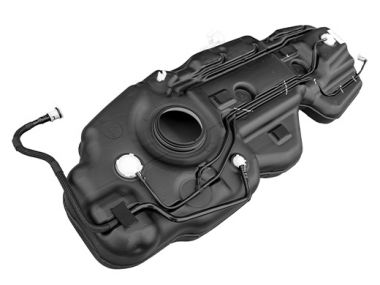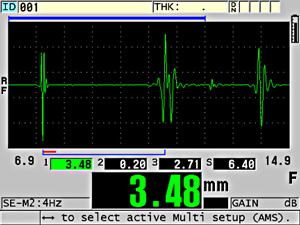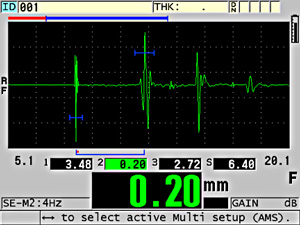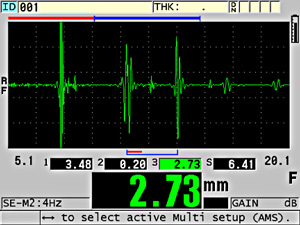
This application note explains how to measure individual layers and total thickness in multilayer plastic automotive fuel tanks.
Background on the Fabrication of Automotive Fuel Tanks
Most contemporary automotive fuel tanks are fabricated with a multilayer plastic construction, typically made of two structural layers of high-density polyethylene (HDPE) surrounding a thin gas barrier layer made of ethylene vinyl alcohol (EVOH). The purpose of the barrier layer is to prevent the slow leakage of gasoline vapor through the polyethylene wall. The HDPE structural layers are typically in the thickness range 0.1 in. to 0.2 in. (2.5 to 5 mm), and the EVOH barrier layer is typically 0.004 in. to 0.012 in. (0.1 to 0.3 mm). Tank manufacturers need to measure both the thickness and the depth of the barrier layer.
Equipment Used to Measure Fuel Tank Wall Thickness
The 39DL PLUS™ ultrasonic thickness gauge with the Multilayer software option is recommended for simultaneous measurement of individual layers and total tank thickness in this application. With this software, the 39DL PLUS gauge can use separately programmed setups (including sound velocity, gain, and blanking settings) for each layer being measured to optimize performance. In this test, the gauge is often used with an M2017-RM (20 MHz) delay line transducer. Contact Evident for gauge setup assistance.
Typical Procedure to Measure the Thickness of Automotive Fuel Tanks
The waveforms below show measurements of structural and barrier layers in a typical automotive fuel tank using appropriate setups. The gauge's frequency-based barrier measurement mode is used to read the barrier layer whenever its thickness is less than approximately 0.010 in. (0.25 mm).
Barrier depth is measured with a conventional Mode 2 setup, and the thickness of the inner polyethylene layer is also measured in Mode 2. Thick barrier layers, greater than approximately 0.010 in. (0.25 mm) may also be measured in Mode 2. Note that because of low pass filtering effects in the outer polyethylene wall, the minimum measurable barrier thickness will usually be approximately 0.004 in. (0.100 mm).
The reflection ratio at the boundary between any two materials is determined by the relative acoustic impedances of those materials. Because virgin and regrind material have essentially identical acoustic impedances, it is not possible to separately measure regrind layers. Also, adhesive layers adjacent to barrier layers are generally too thin and/or too closely impedance matched to measure with ultrasonic techniques and cannot be resolved.

Outer polyethylene layer

Barrier layer (frequency domain measurement)

Inner polyethylene layer
As with any ultrasonic thickness measurement, accuracy is dependent on proper sound velocity calibration. Velocity calibration must be performed for each material being measured, on samples of known thickness.




